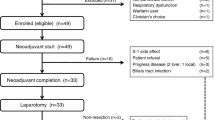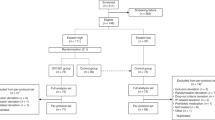Abstract
BC-819 is a DNA plasmid that was developed to target the expression of diphtheria-toxin gene under the control of H19 regulatory sequences. BC-819 has the potential to treat pancreatic cancer that overexpresses the H19 gene. The objectives were to assess the safety, tolerability, pharmacokinetics and preliminary efficacy of BC-819 administered intratumorally in subjects with unresectable, locally advanced, non-metastatic pancreatic cancer. Nine patients with unresectable pancreatic adenocarcinoma were enrolled in an open-label, dose-escalation trial. Subjects were entered into one out of two cohorts with escalating doses of BC-819. Each cohort received 2 weeks of twice weekly intratumoral injection of BC-819 under computerized tomography (CT) (n=3) or endoscopic ultrasound (EUS) (n=6) guidance. Patients were assessed by CT or positron emission tomography (PET)/CT during week 4 for tumor response. The maximum tolerated dose of BC-819 was not reached in this study at the highest dose. Asymptomatic elevation of lipase, which was considered as an adverse event with dose-limiting toxicity, occurred in only one subject in the high-dose group and was resolved spontaneously. The tumors did not increase in size 4 weeks after initiating treatment. Two weeks after completing the treatment, the two subjects who went on to receive subsequent chemotherapy or chemoradiation therapy, pancreatic tumors were downstaged and considered surgically resectable. Remarkably, three of the six subjects in cohort no. 2 evaluated at month 3 had a partial response. BC-819 can be safely administered intratumorally via EUS- or CT-guided injection at a dose of at least 8 mg per injection weekly twice. BC-819 given locally in combination with systemic chemotherapy may provide an additional therapeutic benefit for the treatment of pancreatic cancer.
This is a preview of subscription content, access via your institution
Access options
Subscribe to this journal
Receive 12 print issues and online access
$259.00 per year
only $21.58 per issue
Buy this article
- Purchase on Springer Link
- Instant access to full article PDF
Prices may be subject to local taxes which are calculated during checkout

Similar content being viewed by others
References
Jemal A, Bray F, Center MM, Ferlay J, Ward E, Forman D . Global cancer statistics. CA Cancer J Clin 2011; 61: 69–90.
El-Kamar FG, Grossbard ML, Kozuch PS . Metastatic pancreatic, cancer: emerging strategies in chemotherapy and palliative care. Oncologist 2003; 8: 18–34.
Gunji N, Oda T, Todoroki T, Kanazawa N, Kawamoto T, Yuzawa K et al. Pancreatic carcinoma: correlation between E-cadherin and alpha-catenin expression status and liver metastasis. Cancer 1998; 82: 1649–1656.
American Joint Committee on Cancer Classification. Cancer Staging Manual. edn. American Joint Committee on Cancer Classification ISBN: 0-387-95270-5.
McGinn CJ, Zalupski MM, Shureiqi I, Robertson JM, Eckhauser FE, Smith DC et al. Phase I trial of radiation dose escalation with concurrent weekly full-dose gemcitabine in patients with advanced pancreatic cancer. J Clin Oncol 2001; 19: 4202–4208.
Burris 3rd HA, Moore MJ, Andersen J, Green MR, Rothenberg ML, Modiano MR et al. Improvements in survival and clinical benefit with gemcitabine as first-line therapy for patients with advanced pancreas cancer: a randomized trial. J Clin Oncol 1997; 15: 2403–2413.
Conroy T, Desseigne F, Ychou M, Bouche O, Guimbaud R, Becouarn Y et al. Folfirinox versus gemcitabine for metastatic pancreatic cancer. N Engl J Med 2011; 364: 1817–1825.
Hazard L . The role of radiation therapy in pancreas cancer. Gastrointest Cancer Res 2009; 3: 20–28.
Scaiewicz V, Sorin V, Fellig Y, Birman T, Mizrahi A, Gallula J et al. Use of H19 gene regulatory sequences in DNA-based therapy for pancreatic cancer. J Oncol 2010; 2010: 178174.
Mizrahi A, Czerniak A, Levy T, Amiur S, Gallula J, Matouk I et al. Development of targeted therapy for ovarian cancer mediated by a plasmid expressing diphtheria toxin under the control of H19 regulatory sequences. J Transl Med 2009; 7: 69.
Sidi A, Ohana P, Benjamin S, Shalev M, Ransom JH, Lamm D et al. Phase I/II marker lesion study of intravesical BC-819 DNA plasmid in H19 overexpressing superficial bladder cancer refractory to bacillus calmette guerin. J Urol 2008; 180: 2379–2383.
Erdmann VA, Barciszewska MZ, Szymanski M, Hochberg A, de Groot N, Barciszewski J . The non-coding RNAs as riboregulators. Nucleic Acids Res 2001; 29: 189–193.
Ariel I, Lustig O, Schneider T, Pizov G, Sappir M, De-Groot N et al. The imprinted H19 gene as a tumor marker in bladder carcinoma. Urology 1995; 45: 335–338.
Ariel I, Ayesh S, Perlman EJ, Pizov G, Tanos V, Schneider T et al. The product of the imprinted H19 gene is an oncofetal RNA. Mol Pathol 1997; 50: 34–44.
Ariel I, Miao HQ, Ji XR, Schneider T, Roll D, de Groot N et al. Imprinted H19 oncofetal RNA is a candidate tumour marker for hepatocellular carcinoma. Mol Pathol 1998; 51: 21–25.
Rachmilewitz J, Goshen R, Ariel I, Schneider T, de Groot N, Hochberg A . Parental imprinting of the human H19 gene. FEBS Lett 1992; 309: 25–28.
Ayesh S, Matouk I, Schneider T, Ohana P, Laster M, Al-Sharef W et al. Possible physiological role of H19 RNA. Mol Carcinog 2002; 35: 63–74.
Matouk I, deGroot N, Mezan S, Ayesh S, Abu-lail R, Hochberg A et al. The H19 non-coding RNA is essential for human tumor growth. PloS ONE 2007; 2: e845.
Vaupel P, Mayer A . Hypoxia in cancer: significance and impact on clinical outcome. Cancer Metastasis Rev 2007; 26: 225–239.
Matouk I, Mazan S, Mizrahi A, Ohana P, Abu-lail R, Fellig Y et al. The oncofetal H19 RNA connection: hypoxia, p53 and cancer. Biochim Biophys Acta 2010; 1803: 443–451.
Pieper-Bigelow C, Strocchi A, Levitt MD . Where does serum amylase come from and where does it go? Gastroenterol Clin North Am 1990; 19: 793–810.
Gress F, Michael H, Gelrud D, Patel P, Gottlieb K, Singh F et al. EUS-guided fine-needle aspiration of the pancreas: evaluation of pancreatitis as a complication. Gastrointest Endosc 2002; 56: 864–867.
Fernandez-Esparrach G, Gines A, Garcia P, Pellisé M, Solé M, Cortés P et al. Incidence and clinical significance of hyperamylasemia afer EUS FNA of pancreatic lesions: a prospective and controlled study. Endoscopy 2007; 39: 720–724.
Mizrahi A, Czerniak A, Ohana P, Amiur S, Gallula J, Matouk I et al. Treatment of ovarian cancer ascites by intra-peritoneal injection of diphtheria toxin A chain-H19 vector: a case report. J Med Case Reports 2010; 4: 228–231.
Acknowledgements
This work was supported by BioCancell Therapeutic, Ltd., Israel.
Author information
Authors and Affiliations
Corresponding author
Ethics declarations
Competing interests
The authors declare no conflict of interest.
Rights and permissions
About this article
Cite this article
Hanna, N., Ohana, P., Konikoff, F. et al. Phase 1/2a, dose-escalation, safety, pharmacokinetic and preliminary efficacy study of intratumoral administration of BC-819 in patients with unresectable pancreatic cancer. Cancer Gene Ther 19, 374–381 (2012). https://doi.org/10.1038/cgt.2012.10
Received:
Revised:
Accepted:
Published:
Issue Date:
DOI: https://doi.org/10.1038/cgt.2012.10
Keywords
This article is cited by
-
Role of therapeutic endoscopic ultrasound in gastrointestinal malignancy- current evidence and future directions
Clinical Journal of Gastroenterology (2022)
-
Silencing of the lncRNA H19 enhances sensitivity to X-ray and carbon-ions through the miR-130a-3p /WNK3 signaling axis in NSCLC cells
Cancer Cell International (2021)
-
Research progress on long non-coding RNAs and their roles as potential biomarkers for diagnosis and prognosis in pancreatic cancer
Cancer Cell International (2020)
-
Long non-coding RNA H19, a novel therapeutic target for pancreatic cancer
Molecular Medicine (2020)
-
Endoscopic Ultrasound-Guided Treatment of Pancreatic Cancer
Current Gastroenterology Reports (2020)



